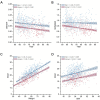Sarcopenic obesity in nursing home residents: a multi-center study on diagnostic methods and their association with instrumental activities of daily living
- PMID: 38773403
- PMCID: PMC11110436
- DOI: 10.1186/s12877-024-04955-w
Sarcopenic obesity in nursing home residents: a multi-center study on diagnostic methods and their association with instrumental activities of daily living
Abstract
Background: Sarcopenic obesity (SO) in nursing home residents is rarely studied. We aimed to evaluate and compare the prevalence and consistency of different SO diagnostic methods and to investigate which criterion demonstrated a stronger association with instrumental activities of daily living (IADL) disability.
Methods: We consecutively recruited older adults aged ≥ 60 years, residing in 15 nursing homes in Zigong City, China. Sarcopenia obesity was defined according to the European Society for Clinical Nutrition and Metabolism (ESPEN) and the European Association for the Study of Obesity criteria (SOESPEN), recommending skeletal muscle mass (SMM) adjusted by body weight (SMM/W) to identify low muscle mass. Further, we adapted ESPEN criteria (SOESPEN-M) by employing SMM adjusted by body mass index (SMM/BMI).
Results: We included 832 participants (median age 73.0 years, 296 women). The prevalence of SOESPEN and SOESPEN-M was 43.5% and 45.3%, respectively. SOESPEN showed good consistency with SOESPEN-M (Cohen's kappa = 0.759). More than one-third of participants in the normal weight group were diagnosed with SOESPEN or SOESPEN-M. Even within the underweight group, the prevalence of SOESPEN and SOESPEN-M was 8.9% and 22.2%, respectively. Participants with IADL disability had significantly lower SMM/W and SMM/BMI, but higher fat mass percentage of body weight (FM%) than participants without IADL disability. After full adjustment for potential confounders, SOESPEN-M (OR 1.68, 95% CI 1.21 to 2.32), but not SOESPEN (OR 1.28, 95% CI 0.93 to 1.75), remained significantly associated with IADL disability.
Conclusions: Both SOESPEN and SOESPEN-M showed a high prevalence among nursing home residents, even among individuals with underweight or normal weight. While SOESPEN had a good consistency with SOESPEN-M, only SOESPEN-M was independently associated with IADL disability. Screening and diagnosis of SO should be conducted in nursing home residents irrespective of BMI.
Keywords: Functional assessment; Long-term care; Muscle quality; Obese sarcopenia; Physical function.
© 2024. The Author(s).
Conflict of interest statement
The authors declare no conflict of interest.
Figures



Similar articles
-
Sarcopenic obesity by the ESPEN/EASO criteria for predicting mortality in advanced non-small cell lung cancer.Clin Nutr. 2023 Jun;42(6):817-824. doi: 10.1016/j.clnu.2023.04.010. Epub 2023 Apr 13. Clin Nutr. 2023. PMID: 37084468
-
Sarcopenic obesity and falls in older adults: A validation study of ESPEN/EASO criteria and modifications in Western China communities.Arch Gerontol Geriatr. 2024 Dec;127:105557. doi: 10.1016/j.archger.2024.105557. Epub 2024 Jul 1. Arch Gerontol Geriatr. 2024. PMID: 38964054
-
Probable and confirmed sarcopenia are still better predictors of disability than sarcopenic obesity following ESPEN/EASO consensus steps.BMC Geriatr. 2025 Apr 15;25(1):250. doi: 10.1186/s12877-025-05897-7. BMC Geriatr. 2025. PMID: 40234752 Free PMC article.
-
Critical appraisal of definitions and diagnostic criteria for sarcopenic obesity based on a systematic review.Clin Nutr. 2020 Aug;39(8):2368-2388. doi: 10.1016/j.clnu.2019.11.024. Epub 2019 Nov 27. Clin Nutr. 2020. PMID: 31813698
-
Prevalence and Diagnosis of Sarcopenia in Residential Facilities: A Systematic Review.Adv Nutr. 2019 Jan 1;10(1):51-58. doi: 10.1093/advances/nmy058. Adv Nutr. 2019. PMID: 30668619 Free PMC article.
Cited by
-
Development and multi-center cross-setting validation of an explainable prediction model for sarcopenic obesity: a machine learning approach based on readily available clinical features.Aging Clin Exp Res. 2025 Mar 1;37(1):63. doi: 10.1007/s40520-025-02975-z. Aging Clin Exp Res. 2025. PMID: 40021576 Free PMC article.
-
Sarcopenic obesity is linked to worse clinical outcomes than sarcopenia or obesity alone in hospitalized older adults.BMC Geriatr. 2025 Jul 2;25(1):443. doi: 10.1186/s12877-025-06105-2. BMC Geriatr. 2025. PMID: 40604522 Free PMC article.
-
Prevalence and Associated Factors of Sarcopenic Obesity Among Nursing Home Residents: A Cross-Sectional Multi-Centre Study.J Cachexia Sarcopenia Muscle. 2025 Jun;16(3):e13821. doi: 10.1002/jcsm.13821. J Cachexia Sarcopenia Muscle. 2025. PMID: 40342219 Free PMC article.
References
-
- Lobstein TJ-LR, Powis J, Brinsden H, Gray M. 2023 [ https://www.worldobesity.org/resources/resource-library/world-obesity-at....
-
- Scott D, Blyth F, Naganathan V, Le Couteur DG, Handelsman DJ, Waite LM, et al. Sarcopenia prevalence and functional outcomes in older men with obesity: comparing the use of the EWGSOP2 Sarcopenia versus ESPEN-EASO sarcopenic obesity consensus definitions. Clin Nutr. 2023;42(9):1610–8. doi: 10.1016/j.clnu.2023.07.014. - DOI - PubMed
MeSH terms
Grants and funding
- 2022YFS0130/Sichuan Science and Technology Program
- 2022YFS0130/Sichuan Science and Technology Program
- 2022YFS0130/Sichuan Science and Technology Program
- 2022YFS0130/Sichuan Science and Technology Program
- 2022YFS0130/Sichuan Science and Technology Program
- 2022YFS0130/Sichuan Science and Technology Program
- 2022YFS0130/Sichuan Science and Technology Program
- 2022YFS0130/Sichuan Science and Technology Program
- No. ZH2023-103/Health and Family Planning Commission of Sichuan Province
- No. ZH2023-103/Health and Family Planning Commission of Sichuan Province
- No. ZH2023-103/Health and Family Planning Commission of Sichuan Province
- No. ZH2023-103/Health and Family Planning Commission of Sichuan Province
- No. ZH2023-103/Health and Family Planning Commission of Sichuan Province
- No. ZH2023-103/Health and Family Planning Commission of Sichuan Province
- No. ZH2023-103/Health and Family Planning Commission of Sichuan Province
- No. ZH2023-103/Health and Family Planning Commission of Sichuan Province
LinkOut - more resources
Full Text Sources
Medical

